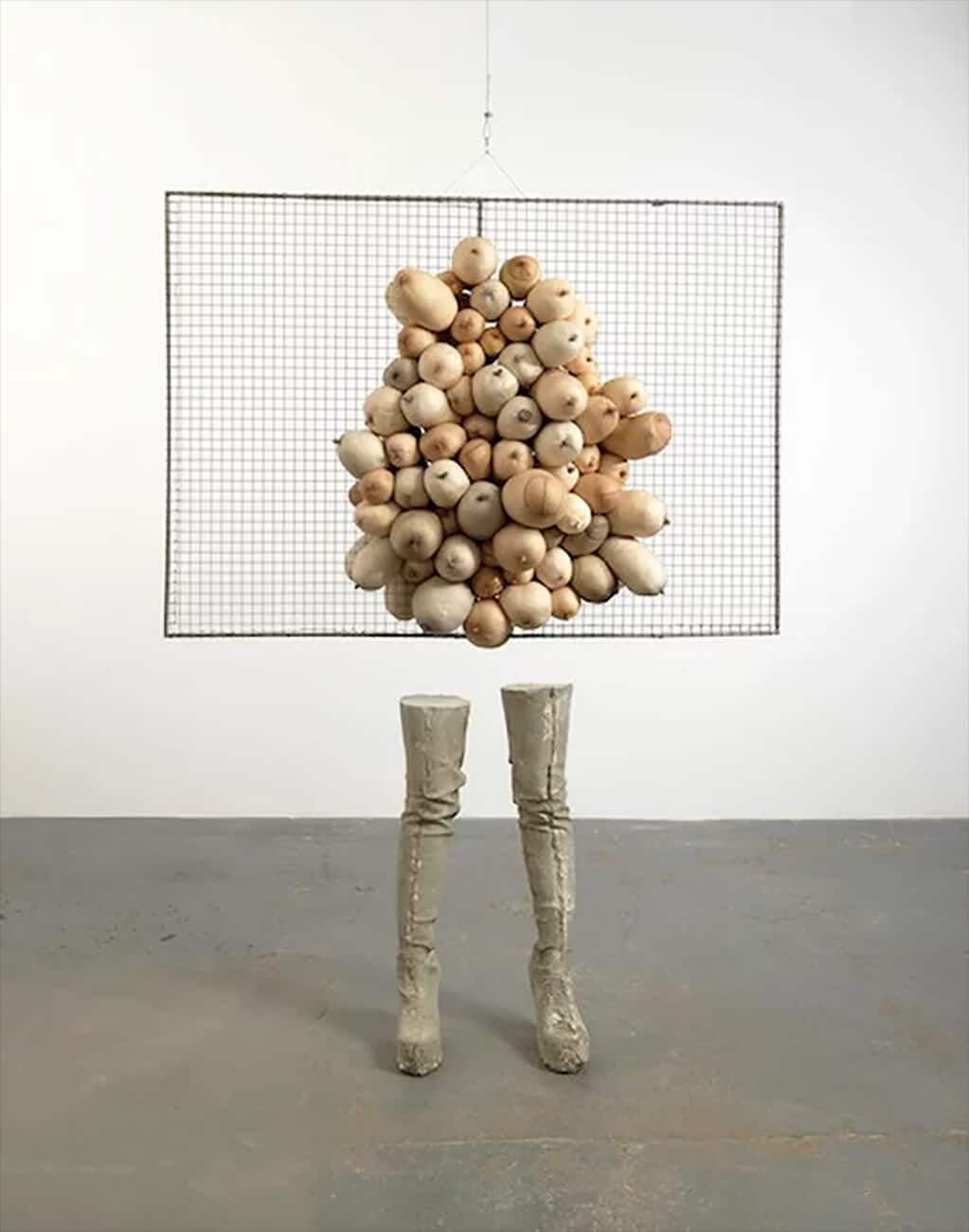Bodily functions, toilet humour, saucy root vegetables - but it's not all laughs and good, clean fun.
I read someone recently describe Sarah Lucas’s sculptures as “aggressive”. Perhaps being greeted by a roomful of huge plaster cocks, mechanised wanking arms and greasy doner kebabs with two fried eggs in an abject arrangement of the female sex can feel a little confrontational, but there’s surely something deflecting and bluntly one-note when it comes to the merely aggressive. “Aggressive” rarely lets other emotions in, and Lucas’s work is a many shaded affair.
There’s humour for a start. And like all the best humour, at least British humour, behind the slapstick there’s sadness and tenderness, as well as a sense of vulnerability and fragility that comes, of course, with “the human condition”. There’s an acute sense of the ridiculous, too. Aggression is too hard-edged, whereas everything in Lucas’s world feels on the edge of collapse of entropy. Those stuffed nylon tights drooping on chairs, those suggestive arrangements of fruit and veg stuffed into sagging fabric, those crumbly chunks of plaster body parts – it smells of sex, but stale, rancid sex, half-suffocated by morning-after cigarette breath and the stink of a nearby latrine (toilets cast in resin the colour of piss). The heat of aggression has gone cold, and the smell of sex grown putrid.
The Whitechapel Gallery’s exhibition is the first retrospective of Lucas in London, which seems surprising, since Lucas is considered by many to be the most important artist to have emerged from the YBA generation. Certainly, she feels like an artist of substance, whereas Damien Hirst feels all but spent – the glitter of expensive tinsel rather than the promised gold. Maybe he’s still yet to surprise, but no-one is holding their breath.
The first gallery in this exhibition is certainly intriguing, and despite the junk-shop aesthetic, beautifully put together. This isn’t a chronological survey but a higgledy juxtaposition of objects spanning 20 years. A motorised mobile spinning wobbly concrete pies rotates above benches whose seats are of poured concrete. You can sit, if you wish, and survey the teeming squalor as if you’re a part of the immersive installation.
There are concrete walls and crushed cars and dejected naked lightbulbs and tables fashioned into schematic women, with kebabs or kippers for pudenda and fried eggs or oranges – the oranges slung into a baggy vest like a great swinging hammock – for tits. In one work, a haunch of pig lies on a heavily soiled mattress, wearing knickers. It looks like a murder scene.
Here are echoes of Franz West, Marcel Duchamp, Louise Bourgeois, and, less obviously but no less pointedly, Allen Jones. But whereas Jones’s glamorous and provocative mannequins-turned-furniture have a cool, slick and celebratory Pop aesthetic, however creakily dated, there is nothing slick or remotely glamorous here.
Art history references go hand-in-hand with tatty tabloid collages from The Sport and The Sun – there’s the one with the sexy dwarf who men go wild over, while in huge blow-up prints Lucas stares down at us in gender-bending James Dean pose. More recent works, from a series called Nuds, are the most affecting – stuffed tights coiled in an entrail-heap of boneless fleshy matter, the knotted sphincter ends exposed as if you’re getting an eyeful of arse. Bodily functions, toilet humour, saucy root vegetables – it all feels very British. But stripped of a “naughty but nice” veneer a grubbier underbelly lies exposed.
Upstairs are cock-shots from the Nineties – though the willies (belonging to Gary Hume, a former boyfriend) are hidden behind an array of stand-in objects. Everything becomes a one-line pun. Two giant plaster cocks point towards the ceiling, one end resembling a dagger, the other is a curved penis. It does begin to pall a little – more of the same, padded out. I’m just glad we’ve skipped the cigarette-covered gnomes and crucifixes – a low point in Lucas’s oeuvre – though there are still a few cigarette pictures. There’s one of Trotsky, apparently, though I imagine few would guess who it was, if indeed that’s who it is.
There’s no doubt that Lucas has a brilliant eye for formal relationships and composition. Her sculptures work on the level of the obvious, but there’s also subtlety and occasionally something rather haunting, too. This is work that is raw, brutal, absurd; it’s all too human.

